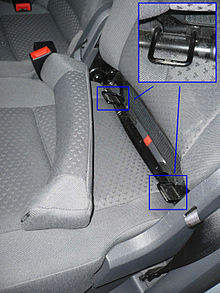用户:CE.BB.CAT/ISOFIX

ISOFIX 是私家车儿童安全座椅接口的国际标准。该标准还有若干区域性命名:在美国,它被称为 LATCH ("Lower Anchors and Tethers for Children") ,而在加拿大,它被称为 LUAS ("Lower Universal Anchorage System") 或 Canfix。[1] 这个标准也被叫做"Universal Child Safety Seat System" 或稍短一点的 UCSSS.
,它规定了第1组儿童安全座椅的锚固系统。它定义了制造成汽车的标准连接点,使得符合要求的儿童安全座椅能够快速安全地固定。 ISOFIX是用安全带固定座椅的替代方案。座椅在顶部(顶部系绳)处具有单个附件并且在座椅的每侧的底部处具有两个附件。从2002年9月开始,美国新车需要该系统的全套锚点。
ISOFIX 代表国际标准化组织的 ISO 13216标准, 它规定了儿童安全座椅的锚固系统。它规定了商品车出厂时须具备的标注接口一边儿童安全座椅便捷地安装。ISOFIX 是用安全带固定座椅之外的另一选择。对于汽车的每侧座椅,他们顶部都有一个接口(供系带连接,防翻覆),底部也有两个卡隼。美国自2002年9月起要求所有新车都符合该标准。
In the EU the system is known as ISOFIX and covers both Group 0/0+ and Group 1 child safety seats. The mechanism for attaching the seat to the Lower Anchors is quite different from that in the United States. In the EU two "alligator-like" clips connect the seat to the Lower Anchors rather than the open clip style connectors commonly used in the United States.[2] However, some child seat manufacturers are beginning to offer true ISOFIX type attachments in the U.S. In the European standard, there are also various installation categories: "universal", "vehicle-specific" and "semi-universal". The main difference is that "Universal" represents use of a top tether strap with the ISOFIX anchorage, "vehicle-specific" represents the usage of the ISOFIX anchorage without the top tether in specified vehicles only, while "Semi-Universal" represents usage of the ISOFIX anchorage together with a "foot-prop".[3][4]
Isofix is designed to secure a maximum combined weight (comprising both seat and child) of 33kg.[5]
The center-to-center distance between the anchors of ISOFIX (and also LATCH) systems is 280 mm.
For Group 2/3 seats there is a system called ISOFIT which anchors the seat to the vehicle so it cannot slide around when not in use. In the case of Isofit, the child is held into the seat using the vehicle's existing seat belt system, not the safety seat's straps.
On September 19, 2014, the Australian government legalized the use of ISOFIX child seats. Prior to this date, their sale (and use) in Australia was illegal.[6]
历史
编辑The ISOFIX system was developed jointly by child safety seat maker Britax-Römer and automobile maker VW, with the first compatible products released in 1997.[7]
ISO 13216 part 1 (covering lower anchorage points) was published in 1999. Part 2, covering top tether anchorages was published in December 2004.[8][9]
Amendments to include ISOFIX in UN ECE Regulations 14 & 44, which specify uniform provisions for the design of vehicle seat anchorages and child safety seats, came into force in February 2004.[10][11]
Under the current UN/ECE R14, all new vehicles produced since February 2013 are required to have ISOFIX lower anchorages and top tether attachments.
参考文献
编辑- ^ Information on LATCH (Lower Anchors and Tethers for CHildren). Car-Safety.Org. February 29, 2008 [2008-07-06].
- ^ Information on ISOFIX/LATCH. Car Safety for Kids Blog. May 8, 2008 [2009-08-03].
- ^ DUO plus Typenliste (PDF). [June 26, 2008].[失效链接]
- ^ SAFEFIX plus Typenliste (PDF). [June 26, 2008].[失效链接]
- ^ Why choose an ISOFIX car seat?. www.bebeconfort.com. [2018-02-11].
- ^ ISOFIX child seats legalised for Australia.
- ^ Britax history and heritage. [April 1, 2014].
- ^ ISO 13216-1:1999. [April 1, 2014].
- ^ ISO 13216-2:2004. [April 1, 2014].
- ^ United Nations ECE Working Party on Passive Safety - Proposal for draft supplement 5 to the 03 series of amendments to Regulation No 44 (PDF). [April 1, 2014].
- ^ UN ECE Regulation No 44 (PDF). [April 1, 2014].